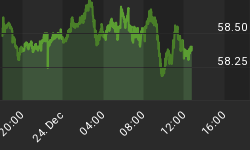Here's an update of the 5 charts shown in my October 21, 2003 communication:
First comes a scatter chart in which the CI-NCI Ratio smoothed by six 10-day moving averages is plotted against the NYSE Trin smoothed by six 10-day moving averages. The time span covers the first 142 trading days after the 4/28/78 and 5/30/03 deep monthly DJIA Coppock Curve buy signals.

Second and third come line charts showing each of the above 2 coordinates separately over the 500 trading days before and after the same 2 signal dates.


Fourth comes the latest update of the Monthly DJIA line chart showing the 24 months before and after the same 2 signals.

Fifth comes a line chart of Peter Eliades' CI-NCI Ratio.

The CI-NCI Ratio appears at last to be topping out. Based on its formula alone (it being a 189 day moving average) the overall trend of this indicator should be biased downward for the next 9 months, even if the DJIA rises. This is because the many positive daily A/D readings which occurred since the start of April have begun dropping out of the equation. A down DJIA would only accentuate this effect.
Meanwhile, the Six by Ten CI-NCI Ratio should top out in about a month. In the coming months, that indicatior should show up in the above scatter chart as a move to the left by the current (green) curve. For it to emulate the 1978 (coral) curve by dropping steeply downward while edging left, a down DJIA in early 2004 would no doubt be required to generate enough large Trin readings.
















